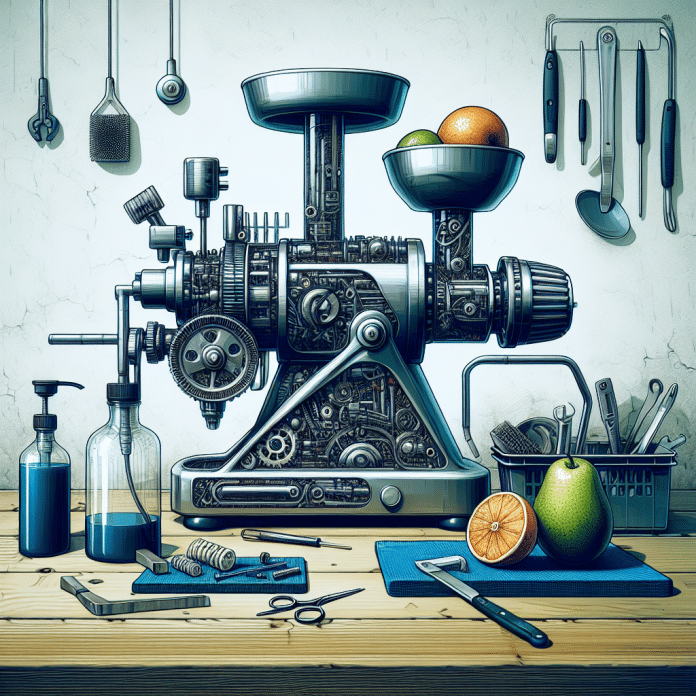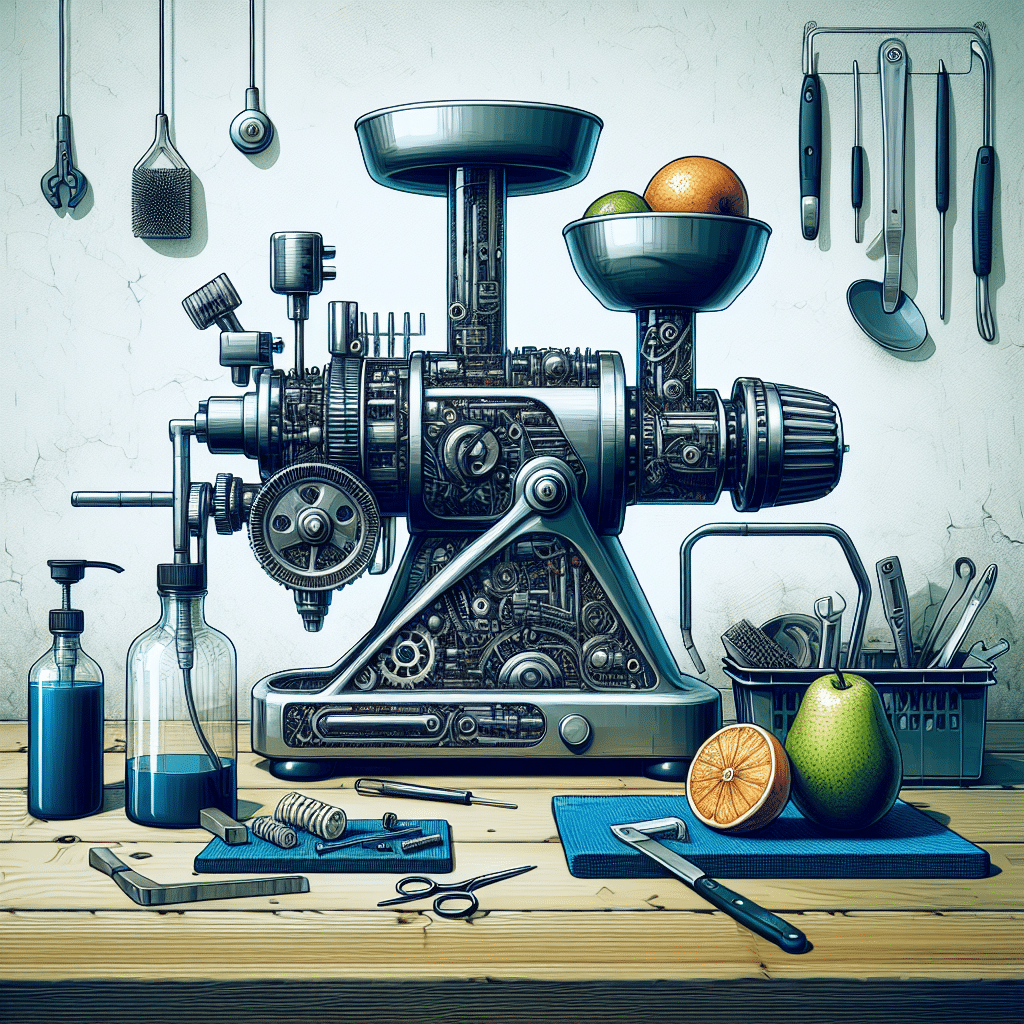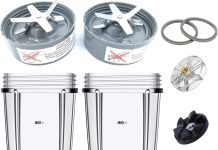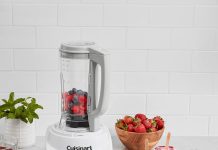If you’re an avid juicer, you may be wondering about the maintenance requirements of masticating juicers. These slow but powerful machines are known for extracting maximum nutrients from fruits and vegetables. But what about the cleaning and upkeep? Fear not, my friend, because in this article, we will explore whether masticating juicers demand regular maintenance or if they are a hassle-free addition to your kitchen. So, grab a glass of freshly squeezed juice and let’s find out!
Review contents
Overview
What are masticating juicers?
Masticating juicers, also known as slow juicers or cold press juicers, are a type of juicing machine that operates at a slower speed than traditional centrifugal juicers. They use a chewing or grinding motion to extract juice from fruits and vegetables, resulting in a higher yield and nutrient retention. Masticating juicers are known for their ability to extract juice from a wide range of ingredients, including leafy greens, wheatgrass, and nuts.
Key benefits of masticating juicers
Masticating juicers offer several key benefits that make them a popular choice among juicing enthusiasts. Firstly, their slow and gentle juicing process helps to preserve the enzymes and nutrients in the juice, resulting in a fresher and more nutrient-dense product. Secondly, masticating juicers are more versatile and can handle a wider variety of produce, including both soft and hard ingredients. They also have the ability to produce less foamy juice with minimal oxidation, which enhances the flavor and shelf life of the juice. Finally, masticating juicers are generally quieter and more durable compared to centrifugal juicers, making them a long-lasting investment for those who are serious about juicing.
Maintenance Frequency
Understanding the maintenance requirements of masticating juicers
Like any other kitchen appliance, masticating juicers require regular maintenance to ensure optimal performance and longevity. While the exact maintenance frequency may vary depending on usage and the specific model, it is generally recommended to clean and carry out routine maintenance at least once a week, or more frequently if the juicer is used daily. This regular maintenance includes cleaning the juicer, sharpening blades, lubricating and aligning components, checking and replacing filters and sieves, caring for the motor, and replacing seals and gaskets when necessary.
Factors affecting maintenance frequency
Several factors can influence the maintenance frequency of masticating juicers. The most significant factor is the frequency of use. If you use your juicer every day, it will require more frequent maintenance compared to occasional use. The types of ingredients you juice can also impact maintenance. For example, juicing fibrous fruits and vegetables or hard ingredients like nuts may cause more strain on the juicer and require more frequent maintenance. Additionally, the specific model and design of the juicer may have unique maintenance requirements, so it is important to refer to the manufacturer’s instructions for guidance.
Cleaning and Disassembly
Importance of regular cleaning
Regular cleaning is crucial for maintaining the performance, hygiene, and longevity of your masticating juicer. When not properly cleaned, residual pulp, juice, and debris can accumulate and lead to clogs, mold growth, and decreased juicer efficiency. Cleaning your juicer after each use ensures that it remains in optimal condition and produces high-quality juice. It also prevents flavors from different ingredients from mixing, ensuring that each batch of juice tastes fresh and pure.
Step-by-step cleaning guide
Cleaning a masticating juicer is a relatively simple process. Here is a step-by-step guide to help you properly clean your juicer:
- Unplug the juicer and disassemble the parts according to the manufacturer’s instructions.
- Rinse the removable components, such as the auger, juice strainer, and pulp container, under warm running water to remove any visible debris.
- Use a soft brush or sponge to scrub the components, paying special attention to any hard-to-reach areas.
- For stubborn residue, soak the parts in warm soapy water for a few minutes before scrubbing.
- Rinse all the components thoroughly with clean water to remove any soap residue.
- Dry the parts completely before reassembling the juicer.
Disassembling and reassembling the juicer
Disassembling and reassembling your masticating juicer correctly is essential to ensure its proper functioning and performance. Follow these steps to disassemble and reassemble your juicer:
- Refer to the manufacturer’s instructions for guidance on how to safely disassemble your specific model of juicer.
- Typically, you will start by removing the pulp container, juice strainer, and auger from the main body of the juicer.
- Pay attention to the order in which the parts are removed to make reassembly easier.
- To reassemble the juicer, reverse the order of the disassembly process, ensuring that each part fits securely and snugly together.
- Make sure all the parts are properly aligned and tightly fastened to prevent any leakage or malfunctioning during juicing.
Blade Sharpening
Signs of dull blades
Over time, the blades of your masticating juicer can become dull, which can hinder the juicing process and yield less efficient results. It’s important to be aware of the signs of dull blades, which may include:
- Difficulty juicing certain ingredients, resulting in reduced juice yield.
- Increased juicing time for the same amount of produce.
- Pulp that is wetter than usual, indicating that the blades are not extracting juice thoroughly.
- Noticeable wear and tear on the blades, such as visible nicks or dents.
Methods to sharpen the juicer blades
Sharpening the blades of a masticating juicer can help restore their efficiency and improve overall juicing performance. There are a few methods you can try to sharpen the juicer blades:
- Manual sharpening: Use a sharpening stone or honing rod to carefully sharpen the blades manually. Follow the manufacturer’s instructions or seek guidance from a professional if you are unsure how to perform this task.
- Replacement blades: Some masticating juicers offer replaceable blades. If your juicer allows for blade replacements, consider purchasing new blades to ensure optimal performance.
- Professional sharpening: If you are uncomfortable sharpening the blades yourself or if they are severely damaged, consider taking your juicer to a professional for blade sharpening services. They have the expertise and tools necessary to safely and effectively sharpen the blades.
Professional blade sharpening options
If you prefer to have your masticating juicer blades sharpened by a professional, you have a few options available. You can reach out to the manufacturer of your juicer to inquire if they offer blade sharpening services. Alternatively, you can contact local kitchen appliance repair shops or specialized sharpening services in your area. They will be able to provide you with information on their services, pricing, and turnaround time for blade sharpening.
Lubrication and Alignment
Why lubrication is necessary
Lubricating your masticating juicer is essential to ensure smooth operation and prevent unnecessary wear and tear on the moving parts. The lubricant helps reduce friction between the components, minimizing heat buildup and extending the lifespan of the juicer. Regular lubrication also helps maintain proper alignment and prevents misalignment, which can lead to juicer malfunctions and decreased juice quality.
Recommended lubrication techniques
When it comes to lubricating your masticating juicer, it’s important to use lubricants specifically designed for food processing equipment. Here are some recommended lubrication techniques:
- Check the manufacturer’s instructions for any specific lubricant recommendations for your juicer model.
- Food-grade lubricants, such as mineral oil or silicone-based lubricants, are commonly used for masticating juicers. Ensure that the lubricant you choose is safe for food contact.
- Apply a small amount of lubricant to the moving parts of the juicer, such as the auger or gears, as instructed by the manufacturer.
- Use a clean cloth or brush to evenly distribute the lubricant and remove any excess.
- Avoid over-lubricating, as this can lead to clogs or contamination of the juice.
Ensuring proper alignment of components
Proper alignment of the components is crucial for the smooth operation and performance of your masticating juicer. Here are a few tips to ensure proper alignment:
- Carefully follow the manufacturer’s instructions for disassembling and reassembling the juicer to ensure that all parts are aligned correctly.
- Check for any visible signs of misalignment, such as parts not fitting together snugly or excessive wobbling during operation.
- If you notice misalignment, refer to the manufacturer’s troubleshooting guide or contact customer support for assistance.
- Avoid applying excessive force or torque when tightening the juicer components, as this can cause misalignment or damage to the machine.
Filter and Sieve Maintenance
Cleaning and replacing the filter
The filter of a masticating juicer plays a crucial role in separating the juice from the pulp. Regular cleaning and occasional replacement of the filter are necessary to maintain the juicer’s performance. Here’s how to clean and replace the filter:
- Remove the filter from the juicer according to the manufacturer’s instructions.
- Rinse the filter under running water to remove any residue or pulp.
- Use a soft brush or sponge to gently scrub the filter, removing any stubborn particles.
- If the filter is heavily stained or damaged, it may be time to replace it. Consult the manufacturer’s instructions or contact customer support to inquire about purchasing a replacement filter.
Maintaining the sieve
The sieve of a masticating juicer is responsible for further straining the juice, ensuring a smooth and pulp-free consistency. To maintain the sieve and prolong its lifespan, follow these steps:
- Remove the sieve from the juicer and rinse it under running water to remove any pulp or debris.
- Use a soft brush or sponge to gently scrub the sieve, paying attention to any clogged or hard-to-reach areas.
- If the sieve has developed stubborn stains or residue, soak it in warm soapy water for a few minutes before scrubbing.
- Rinse the sieve thoroughly to remove any soap residue.
- Allow the sieve to air dry completely before reassembling it into the juicer.
Checking for clogs
Clogs can significantly impact the performance of your masticating juicer, leading to decreased juice yield and potential damage to the machine. Regularly checking for clogs and taking preventative measures can help ensure smooth juicing. Here’s what you can do:
- Pay attention to the juicing process and monitor the flow of juice and pulp.
- If you notice a decrease in juice production or a buildup of pulp, stop the juicer and check for clogs.
- Use a small cleaning brush or a soft sponge to clear any visible clogs in the juice strainer or auger.
- If the clog persists, refer to the manufacturer’s instructions for guidance on troubleshooting or seek assistance from customer support.
Motor Care
Understanding the motor’s role
The motor is an essential component of a masticating juicer as it drives the juicing process. Caring for the motor is crucial to ensure its longevity and prevent overheating or breakdowns. Understanding the motor’s role can help you take the necessary precautions to keep it in optimal condition.
Preventing overheating
Overheating is a common issue with masticating juicers, especially if they are used for extended periods or if the motor is subjected to excessive strain. To prevent overheating:
- Avoid running the juicer continuously for more than the recommended time specified by the manufacturer.
- Take regular breaks during juicing to allow the motor to cool down.
- Juice in smaller batches rather than overloading the juicer with excessive produce.
- If you feel excessive heat radiating from the motor or notice a burning smell, immediately turn off the juicer and allow it to cool down before resuming use.
Cleaning the motor
While masticating juicers are designed to prevent liquid from coming into direct contact with the motor, occasional cleaning is still necessary to remove any dust or debris that may accumulate. Here’s how to clean the motor:
- Ensure that the juicer is unplugged and follow the manufacturer’s instructions on how to access the motor.
- Use a soft, dry cloth or a small brush to gently wipe away any dust or debris from the motor.
- Be cautious not to apply excessive pressure or force that could cause damage to the motor.
- Do not use water or any liquid cleaners on the motor, as this can lead to electrical hazards or damage to the machine.
When to seek professional motor service
If you encounter any motor-related issues with your masticating juicer that you are unable to resolve through regular maintenance, it may be necessary to seek professional motor service. Signs that you should consider professional assistance include:
- Persistent overheating, even with proper usage and maintenance.
- Unusual noises or grinding sounds coming from the motor during operation.
- Inability to start or irregular motor functioning.
- Any visible signs of motor damage or electrical issues.
Seal and Gasket Replacement
When to replace the seal and gasket
The seal and gasket of a masticating juicer help prevent leakage and ensure a tight seal between the juicer components. Over time, they may wear out or become damaged, compromising the juicer’s performance. Here are some signs that indicate the need for seal and gasket replacement:
- Leakage from the juicer during operation.
- Difficulty in achieving a proper seal between the components.
- Visible wear and tear, such as cracks or deformation, on the seal and gasket.
- Prolonged use without replacing the seal and gasket, even after other maintenance efforts have not improved performance.
Step-by-step guide for replacing the seal and gasket
Replacing the seal and gasket of a masticating juicer can help restore its proper functioning. Follow these steps to replace the seal and gasket:
- Refer to the manufacturer’s instructions for guidance on accessing and replacing the seal and gasket of your specific juicer model.
- Start by safely disassembling the necessary components to access the seal and gasket.
- Remove the old seal and gasket, making note of their position and alignment.
- Clean the area around the seal and gasket thoroughly to ensure a clean and proper seating for the new components.
- Place the new seal and gasket in the correct position, aligning them with the corresponding slots or grooves.
- Carefully reassemble the juicer components, ensuring that all parts fit securely and tightly together.
- Test the juicer to ensure that the new seal and gasket provide a proper seal and prevents any leakage.
Storage and Usage Tips
Proper storage guidelines
Proper storage of your masticating juicer when not in use is essential for maintaining its condition and performance. Here are some storage guidelines to follow:
- Clean and dry all the juicer components thoroughly before storing to prevent mold, bacteria growth, or damage from residue.
- Store the juicer in a cool and dry place, away from direct sunlight or excessive heat.
- If possible, disassemble the juicer and store the components separately to prevent any deformation or damage.
- Consider placing the juicer in its original packaging or a protective case to prevent dust accumulation and potential damage.
Tips for maximizing juicer lifespan
To maximize the lifespan of your masticating juicer and ensure optimal performance, consider implementing these tips:
- Follow the manufacturer’s instructions for usage, care, and maintenance.
- Juice a variety of ingredients, including soft and hard produce, to evenly distribute the workload on the juicer components.
- Avoid overloading the juicer with excessive amounts of produce at once to prevent strain on the motor and other components.
- Clean the juicer promptly after each use to prevent residue buildup and clogs.
- Regularly inspect the juicer for any signs of wear and tear, and address any maintenance requirements promptly.
- Use the juicer according to its intended purpose, avoiding excessive force or using it for tasks it is not designed for.
Warranty and Support
Understanding the juicer’s warranty
Before purchasing a masticating juicer, it’s important to understand the warranty coverage provided by the manufacturer. Warranty terms, duration, and conditions can vary depending on the brand and model. Familiarize yourself with the warranty details, including what is and is not covered, as well as any specific maintenance requirements or restrictions that may apply.
Available customer support options
Having access to reliable customer support can be invaluable when seeking advice or assistance with your masticating juicer. Here are some customer support options that may be available:
- Manufacturer’s support line: Many juicer manufacturers provide customer support through a dedicated phone line or email. Contact the manufacturer directly to inquire about the support options available and how to reach their support team.
- Online resources: Manufacturers often provide online resources such as troubleshooting guides, FAQs, and instructional videos on their websites. These resources can be helpful for addressing common issues and finding solutions.
- User communities and forums: Online communities and forums dedicated to juicing or specific juicer brands can provide a wealth of information, tips, and support from experienced juicers and other owners of the same juicer model.
In conclusion, masticating juicers do require regular maintenance to ensure optimal performance and longevity. By understanding the maintenance requirements, properly cleaning and disassembling the juicer, sharpening the blades, lubricating and aligning components, maintaining the filter and sieve, caring for the motor, replacing seals and gaskets when necessary, following storage and usage guidelines, and utilizing available warranty and customer support options, you can ensure your masticating juicer remains in excellent condition for years to come.


































